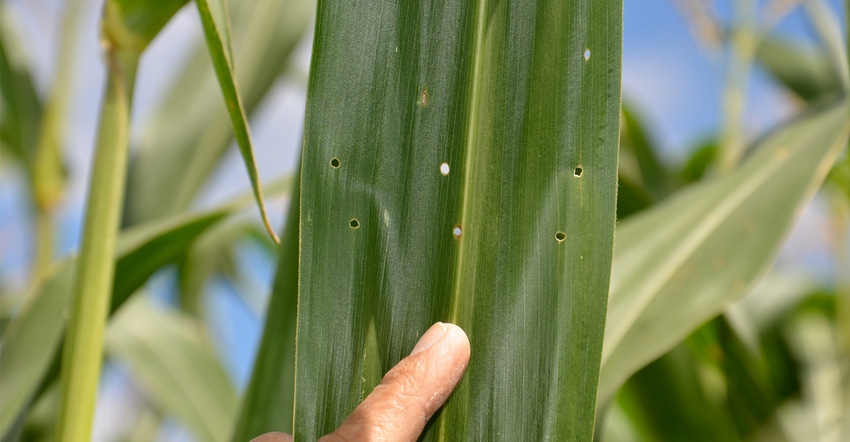
You never know what you may find if you keep your eyes peeled while scouting cornfields. In one field, a consultant found the leaf pictured here. It exhibits what appears to be shot-hole feeding. That type of feeding occurs when an insect larva chews through leaves in the whorl. Once the leaves unfurl, there is a pattern of holes made by the insect chewing its way through leaves that were still rolled up.
Typically, people find shot-hole feeding earlier in the season, when corn is knee- to waist-high. It’s often attributed to first-generation European corn borer. Finding it hasn’t been as common since many farmers have shifted to Bt hybrids with protection against aboveground pests, particularly European corn borer.
What is unusual about this leaf with shot holes, which was found on a late-season scouting trek, is that it was high on the plant — well above the ear leaf. Having done his homework, the consultant who found the leaf knew that one hybrid within the field did not have Bt protection for aboveground pests. So he began to suspect insect damage.
Puzzle pieces
But how did the damage occur on leaves higher up in the plant? The consultant turned to John Obermeyer, Purdue University Extension entomologist, for answers. “Leaves which emerge later in the season are still rolled up in the whorl at some point before they emerge,” Obermeyer says. “If an insect larva was present then, it could have chewed through the leaves, just like a larva would chew through leaves in the whorl earlier in the season.”
So did second-generation corn borer larvae cause this type of damage? “There is really no way to say for sure,” Obermeyer says. “There are several insects that produce larvae that could have chewed through leaves and left that type of damage.”
Other possible suspects include fall armyworm and corn earworm, he notes. “Unless you actually find the insect in the plant, you can’t be sure which type of insect actually caused the damage.”
What to do?
There is actually nothing you can do this season once you see those kinds of holes in leaves, especially if you can’t find larvae, Obermeyer says. The insects are likely already inside stalks and ear shanks. That’s why trying to treat for something like second-generation corn borer is so difficult, he notes. Once larvae feed and bore into stalks, there’s no good way to reach them with insecticides.
There are two things you can do, however — one to perhaps salvage more yield this year and one to prepare for next year. If the culprit is corn borer, yield loss could come from dropped ears or from stalks that break after insect tunneling. Insect entry wounds can also open a path for secondary disease infections.
“You can scout that field carefully and mark it for early harvest if you see stalks breaking over or see signs of disease,” Obermeyer says.
As for next year, if you determine there was significant corn borer feeding this year, select a Bt hybrid with corn borer protection next time.
About the Author(s)
You May Also Like




